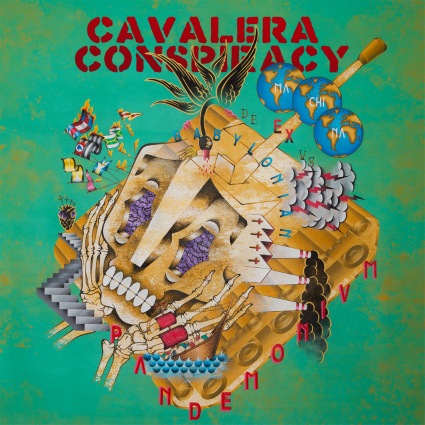Mark Reale encouraged band to carry on after his death
By Peter Lindblad
By Peter Lindblad
 |
| Riot V is bassist Don Van Stavern, guitarists Mike Flyntz and Nick Lee, vocalist Todd Michael Hall and drummer Frank Gilchriest |
In 2012, the founding guitarist of heavy-metal cult favorites Riot died after an almost lifelong battle with Crohn's Disease, only months after the reunited Thundersteel-era lineup released the power-metal tour de force Immortal Soul.
His passing shocked and saddened the metal community, and many figured Riot, having been through so much in its 30-odd years of existence, was not long for this world either. Reale wasn't having any of it.
Having formed Riot in 1975 with drummer Peter Bitelli as a powerhouse, straightforward metal outfit capable of produced such blazing classics as Narita and Fire Down Under, Reale was the one constant in Riot's existence, reviving and reshaping the band after devastating personnel losses and orchestrating Riot's transformation as a storming power-metal beast on 1988's Thundersteel with new partner Don Van Stavern.
It was Reale who urged his comrades to forge ahead in his absence, as Van Stavern and guitarist Mike Flyntz conspired to write the compelling material for Unleash The Fire, the electrifying new album from a unit rechristened Riot V that includes drummer Frank Gilchriest, guitarist Nick Lee and Todd Michael Hall, a vocalist of extraordinary power and expression.
Flyntz talked in this interview about Riot V's new adventures, Reale's final days and how Riot V carried on after the death of their leader to bring Unleash The Fire to life.
Mike Flyntz: Besides the obvious musical and emotional difficulties the hardest part was not having Mark there for the final everyday decisions. Mark was very generous with letting everyone involved contribute ideas. He let everyone shine. In the end he would decide on different arrangements and tempo changes etc. Don and I had to make all the final decisions for this record.
They say that tragedy that can sometimes unite and strengthen the bonds between survivors. In that respect, did the writing and recording of Unleash the Fire bring the remaining members of the band closer together, or was it a difficult process?
MF: We were on a mission to make the best record possible since it was written for Mark. We had big shoes to fill and most people didn’t think we could do it or if it was even possible without Mark. We were very close and Mark’s spirit was with us the entire time.
In what ways does the new album seem reminiscent of Thundersteel? That album was such a classic, and a lot of the elements that it made it so special are here as well.
MF: Todd’s voice mixed with the songwriting I think are the main components. Also Don Van Stavern wrote eight of the songs on the new record. He was also a main writer of Thundersteel along with Mark.
“Bring the Hammer Down” and "Return of the Outlaw" are such phenomenal tracks. The singing makes the hair on your arms stand up, and so do the guitar riffs. Was there a real sense of excitement in the air when those songs in particular were being recorded?
MF: The music was done first. Although we heard the demos we really didn’t realize how much Todd was going to step up to the plate until the music was recorded. We were blown away when he added his vocals.
As much as anything, Unleash the Fire is great guitar album, with really strong, tight riffs, fiery solos and really interesting, melodic dual leads. What did you hope to do instrumentally on this record in tribute to Mark?
MF: Our main focus was to stay true to traditional Riot and to honor Mark. I just wrote all the guitar parts the same way Mark and I would over the past 25 years. Mark always liked to combine melodic parts with bluesy elements.
Mark encouraged the band to continue on after his death. Why did he feel that it was important to do so, and how much pressure was there in trying to make a record that would make him proud?
MF: During the recording of Immortal Soul Mark was having trouble recording his parts. He told me to record the parts, and he would come in when he was better. I wound up doing all the solos and 90 percent of the rhythm guitars. He heard the recordings and approved them. He was very proud of us and said to keep going. We didn’t realize how sick he was.
What inspired the words to “Land of the Rising Sun” and was there a sense that you wanted to make a more hopeful statement with the lyrics here?
MF: Don wrote this about our first trip to Japan in 1989. We were shocked at the reception at the airport and the hotel. There were hundreds of people awaiting our arrival. We felt like the Beatles. We will never forget this and chose to write a song for them to say thanks.
Going back to Thundersteel, just before that Riot was trying to rebuild and re-establish itself after some problems with record labels and some lineup shuffling. Even though you weren't in the band then, what are your thoughts about that record?
MF: Mark did want to experiment with a new sound and Donnie was real influential in the Thundersteel sound. A lot of older fans didn’t like the change. On the other hand, there was an entire different fan base developed with the new sound.
What are your impressions of that record today? Was it somewhat ahead of its time?
MF: I think the songs are great. It was ahead of it’s time. When we play live the Thundersteel songs are constantly requested and always go over the best.
With The Privilege of Power, that was such an experimental album, with the use of horns. What did you think of it?
MF: I think it was a great idea. Everything in life is timing. Not sure if the timing was right with the grunge era approaching, but who knew?
It is natural, given all the lineup changes over the years, to wonder how solid this version of Riot is. Is it different this time around? Do you sense that this group could stay around for a while, or are you guys just trying to live in the moment and not think too much about the future?
MF: We are looking towards the future now. At first our idea was to pay tribute to Mark and see how the fans reacted. Due to the blessing and constant support from the Riot fans it is obvious to us that we should continue. As long as Mr. Reale and the fans want it we will continue.
What would be the greatest compliment you could receive with regard to this new record?
MF: Already happened. The fans have spoken. The fans have showed overwhelming support and enthusiasm over this new record. To our surprise the writers and critics have all joined in too. We are so thankful.
Where there moments in the making of Unleash the Fire where you said to yourself or to the others, “Mark would have really liked that,” or, on the other hand, “Mark would have really hated that”?
MF: There wasn’t a day when Mark’s name didn’t come up whether we were asking “how
would he do it” or just joking about things he would have said. We constantly used Mark’s sayings and jokes throughout the entire recording process.
I have to ask about the cover. You used the seal from Fire Down Under, and you’ve utilized it extensively for Riot album art. What is the story behind its use and why was it important to bring it back for this record?
MF: Not sure where it came from. It is referred to as “Mighty Tior” or “Johnny”. Since the album was a dedication to Mark and the entire Riot catalog we wrote music and used themes that combined all the eras of Riot’s history.
What’s next for Riot?
MF: We look forward to touring and then doing another record and DVD.



















